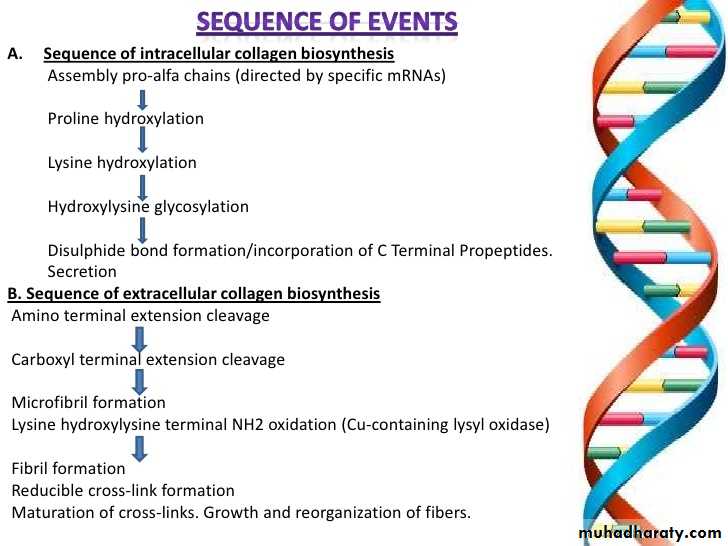Fibrous Proteins
CollagenCollagen and Elastin are examples of common,well-characterized fibrous proteins that serve structural functions in the body.
They are found as components of skin,
connective tissue, blood vessel walls, sclera and cornea of the eye. Each fibrous protein exhibits
special mechanical properties, resulting from its unique structure, which are obtained by combining specific amino acids into regular, secondary structure elements.
Collagen is the most abundant protein in the human body. A typical collagen molecule is a long, rigid structure in which three polypeptides (α-chains) are wound around one another in a rope-like triple helix.
COLLAGEN
Although these molecules are found throughout the body, their types and organization are dictated by the structural role collagen plays in a particular organ.
In some tissues, collagen may be dispersed as a gel that gives support to the structure, as in the vitreous humor of the eye.
In other tissues, collagen may be bundled in tight, parallel fibers that provide great strength, as in tendons.
Collagen of bone occurs as fibers arranged at an angle to each other so as to resist mechanical shear from any direction.
The superfamily of proteins includes more than twenty collagen types. The three polypeptide α-chains are held together by hydrogen bonds between the chains.
Variations in the amino acid sequence of the α-chains result in structural components that are the same size, but with slightly different properties. These α-chains are combined to form various types of collagen.
Types of Collagen
I- Amino acid sequence:
Collagen is rich in Proline and Glycine, both of which are important in the formation of the triple-helix (its ring structure, the smallest amino acid, respectively).The Glycine residues are part of the repeating sequence, (-Gly-X-Y-), where X is frequently Proline and Y is often Hydroxyproline (Hyp) or Hydroxylysine (Hyl). Thus, the α-chain can be regarded as a polypeptide whose sequence can be represented as (-Gly-X-Y-)333.
(--gly---x---y---gly---X---Y--)
Structure of Collagen
II- Triple-helical structure:
Collagen has an elongated, triple-helical structure that places many of its amino acid side chains on the surface of the molecule.III- Hydroxyproline (Hyp) & Hydroxylysine (Hyl):
Collagen contains Hyp and Hyl, which result from the hydroxylation of some of the Proline and Lysine residues after their incorporation into polypeptide chains
In contrast to collagen, elastin is a connective
tissue protein with rubber-like properties. Elastinfibers composed of elastin and glycoprotein
Micro fibrils can found in the lungs, and large arteries walls. They can be stretched to several times their normal length, but recoil to their original shape when the stretching force is relaxed.
ELASTIN







